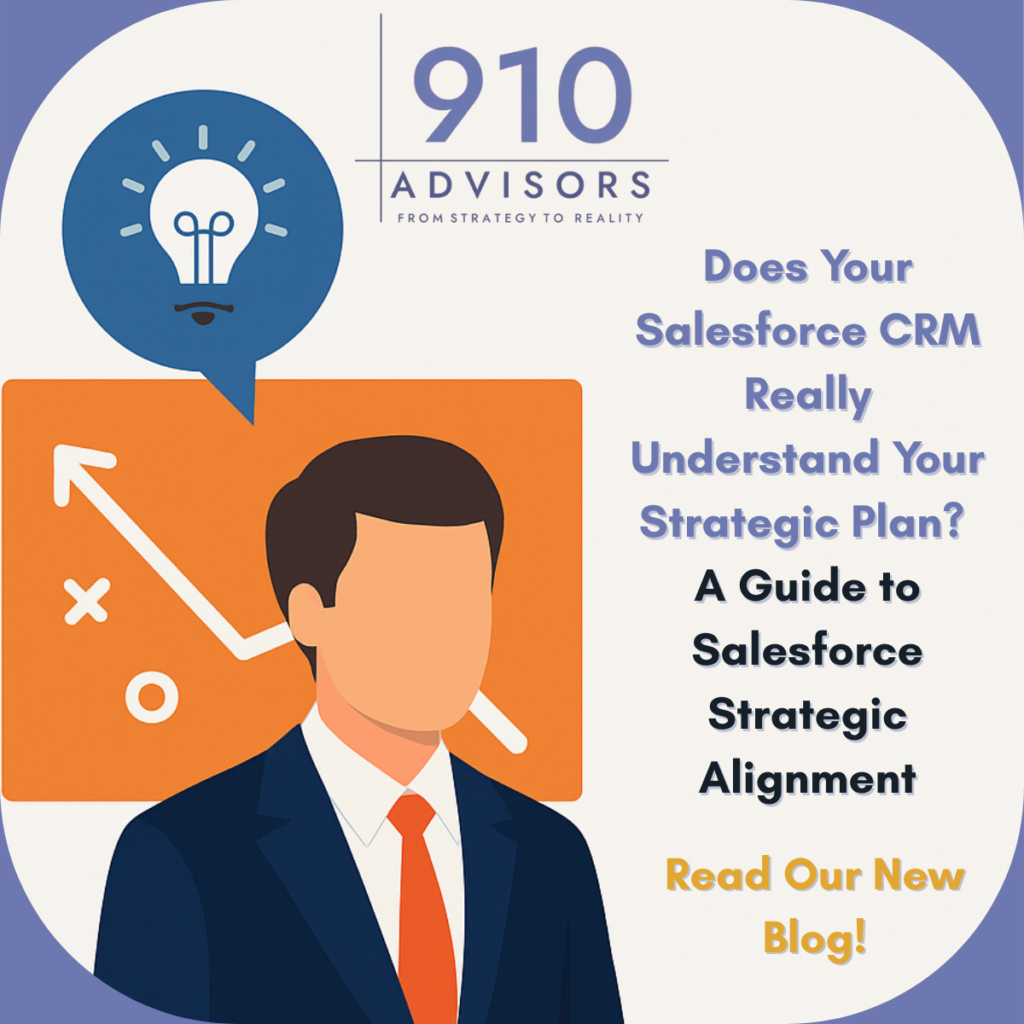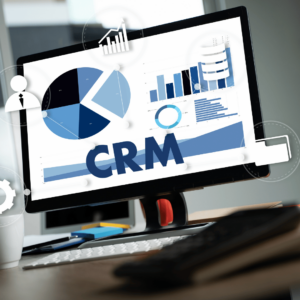The Salesforce CRM Disconnect
You’ve invested time, resources, and energy into building a robust strategic plan. You’ve also deployed Salesforce CRM — one of the most powerful and customizable CRM platforms on the market, to support your business development efforts. But here’s the real question: Does your Salesforce CRM Actually Reflect Your Strategic Plan?
Far too often, companies use Salesforce as a digital Rolodex or a glorified reporting tool rather than as a strategic engine that drives measurable progress toward business goals. The result? Misalignment, inefficiency, and lost revenue.
Let’s explore how organizations can ensure their Salesforce CRM isn’t just operational, it’s strategically aligned.
Strategy Without Integration Is Just Theory
One of the most common issues we see at 910 Advisors is the disconnect between C-suite-level strategy and Salesforce CRM configuration. A strong strategic plan outlines goals like market expansion, product penetration, or client retention — but if Salesforce isn’t configured to capture and advance those goals, the system falls flat.
Too many sales and marketing teams are using outdated or incomplete fields, default opportunity stages, or workflows that haven’t been updated since the initial Salesforce implementation. Strategic alignment means customizing Salesforce CRM to your specific objectives, KPIs, and customer journey.
🧠 Pro tip: Conduct a quarterly Salesforce CRM audit to ensure your object model, custom fields, process builder flows, and dashboards are aligned with your latest strategic initiatives.
According to Salesforce, companies that tailor their CRM platform to their business strategy experience higher levels of adoption, engagement, and return on investment.
Are Your Teams Using Salesforce With Purpose?
Even the best Salesforce configuration won’t succeed without user buy-in. Ask yourself: Do your team members understand why they’re entering data into Salesforce? Do they see how it helps drive business goals?
Salespeople are goal-driven, and they’ll only engage with Salesforce if they see clear benefits. When strategy is siloed at the top and never translated into actionable Salesforce workflows, user adoption suffers.
🔍 Quick check: Are your reports and dashboards aligned with the strategic outcomes your leadership wants to track? If not, your Salesforce CRM isn’t serving your mission.
Strategic CRM alignment means mapping every user interaction — from logging a lead to closing a deal — back to broader business objectives.
Forrester’s research shows that CRM success is 70% dependent on people and process alignment, not technology alone.
Strategic Goals Must Be Built Into Salesforce Itself
If your strategic goal is to increase customer retention, your Salesforce CRM should include:
- Custom fields tracking churn risk indicators
- Flow automations or process builder actions for follow-up tasks
- Reports and dashboards flagging accounts without recent engagement
Want to drive more upsells? Then your opportunity stages, product selections, and account views must be tailored accordingly.
Simply put: your Salesforce CRM must be a living, breathing reflection of your strategic priorities.
At 910 Advisors, we help clients identify critical alignment gaps and configure Salesforce CRM to bridge them. When CRM workflows, automation, and data structures are built around strategy, your business operates with clarity and purpose.
Communication Is the Missing Link
Many business leaders assume their Salesforce CRM strategy is clear, but assumptions don’t build alignment. If your sales, marketing, and service teams aren’t involved in strategic discussions and CRM decisions, they’re left executing in the dark.
Strategic alignment requires top-down and bottom-up communication. Leadership should provide vision, while frontline teams offer insights into what data and processes are actually useful in Salesforce.
🗣️ Actionable idea: Host monthly Salesforce CRM feedback sessions across departments. Use the input to refine dashboards, build automation, and update required fields.
When everyone has a voice, Salesforce CRM becomes more than just a platform, it becomes a strategic hub.
Metrics That Matter: Align Reporting With Strategy
If your Salesforce reports don’t reflect strategic KPIs, they’re just vanity metrics. Are you tracking activity or outcomes? Volume or value? Strategy starts with choosing the right metrics and ends with embedding them into every layer of your Salesforce CRM.
For example:
- If growth is a priority, your reports should highlight opportunity pipeline health, sales cycle velocity, and lead conversion rates.
- If customer experience is key, use dashboards showing case resolution time, CSAT, and engagement trends.
Too often, leadership measures success on Excel while sales teams operate in Salesforce. Strategic alignment means syncing those worlds.
📊 Use Salesforce tools like Lightning Reports, Dashboards, and CRM Analytics (formerly Tableau CRM) to visualize strategic progress in real time.
Training & Change Management: A Non-Negotiable
Strategic use of Salesforce CRM isn’t intuitive, it’s trained. And training isn’t a one-time event. As your strategy evolves, so must your CRM skills and workflows.
We’ve seen teams make huge investments in Salesforce only to suffer from poor adoption, data inconsistency, and resistance to change. Why? Because they didn’t make strategic training part of the culture.
💡 Recommendation: Develop a Salesforce enablement program that evolves with your strategic objectives. Combine Trailhead modules, in-person coaching, and interactive guides like Salesforce In-App Guidance.
When CRM proficiency is tied to performance goals and reinforced over time, your people, and your platform, can evolve together.
A Strategic Salesforce CRM Is a Competitive Advantage
Salesforce CRM is more than a sales tool, it’s the foundation of how you execute your business strategy. If it’s not aligned, your teams are running in different directions with no unified purpose.
True strategic alignment requires:
- Configuring Salesforce CRM to reflect business priorities
- Training your team to understand and act on those goals
- Building a feedback loop between strategy, systems, and people
At 910 Advisors, we specialize in bridging the gap between vision and execution in Salesforce. If you’re ready to transform your CRM into a strategic asset rather than a static system, we can help.
🔗 Contact us today to learn more. Visit www.910advisors.com for more information


